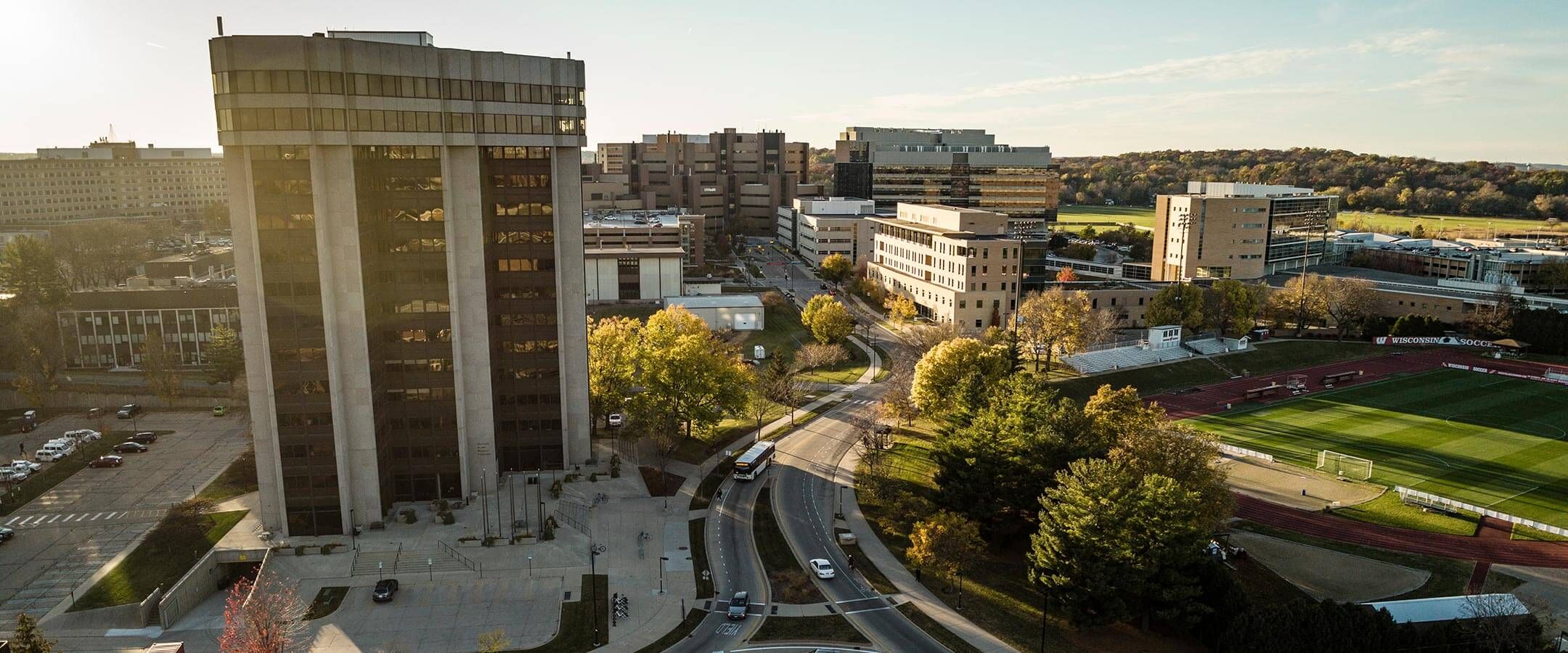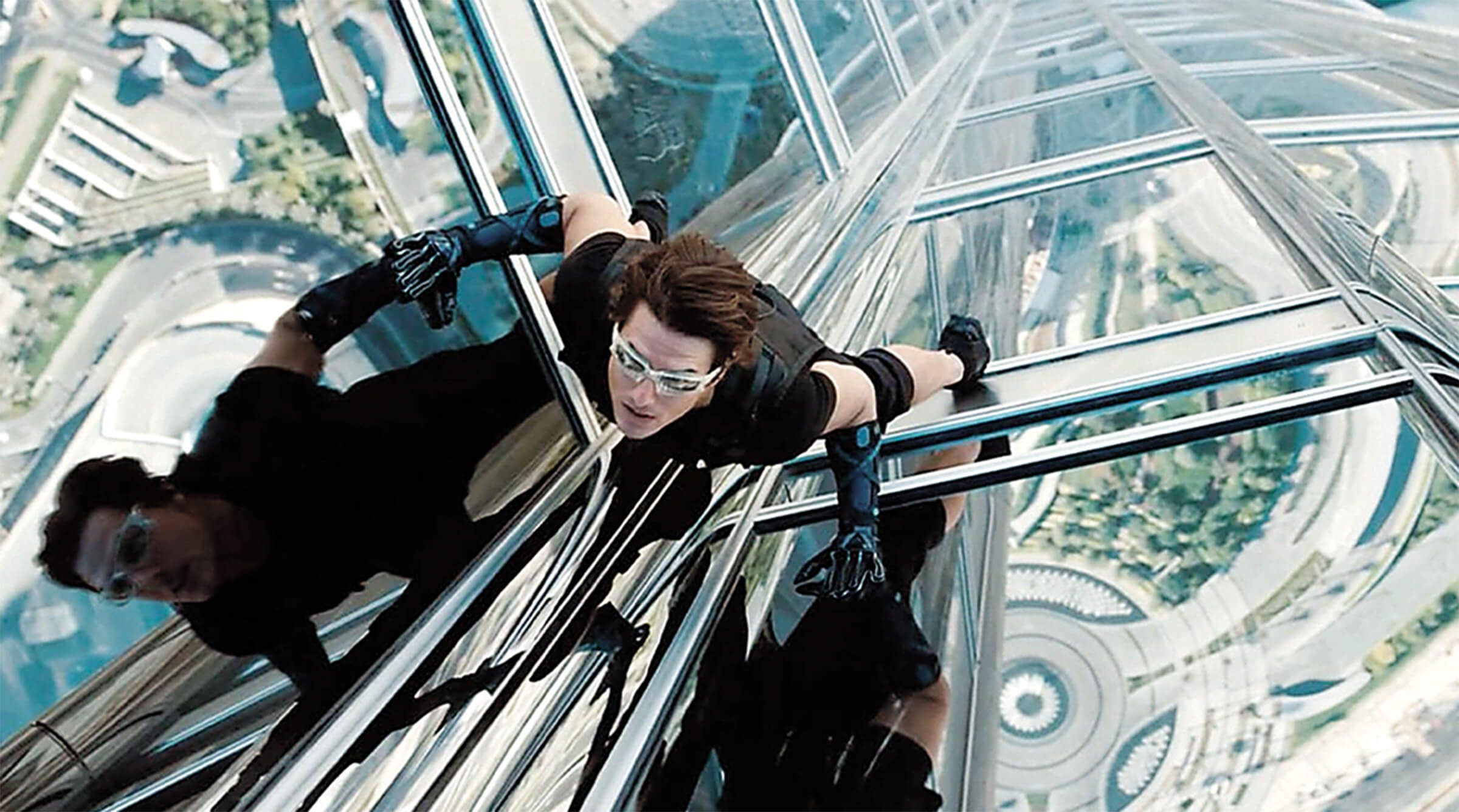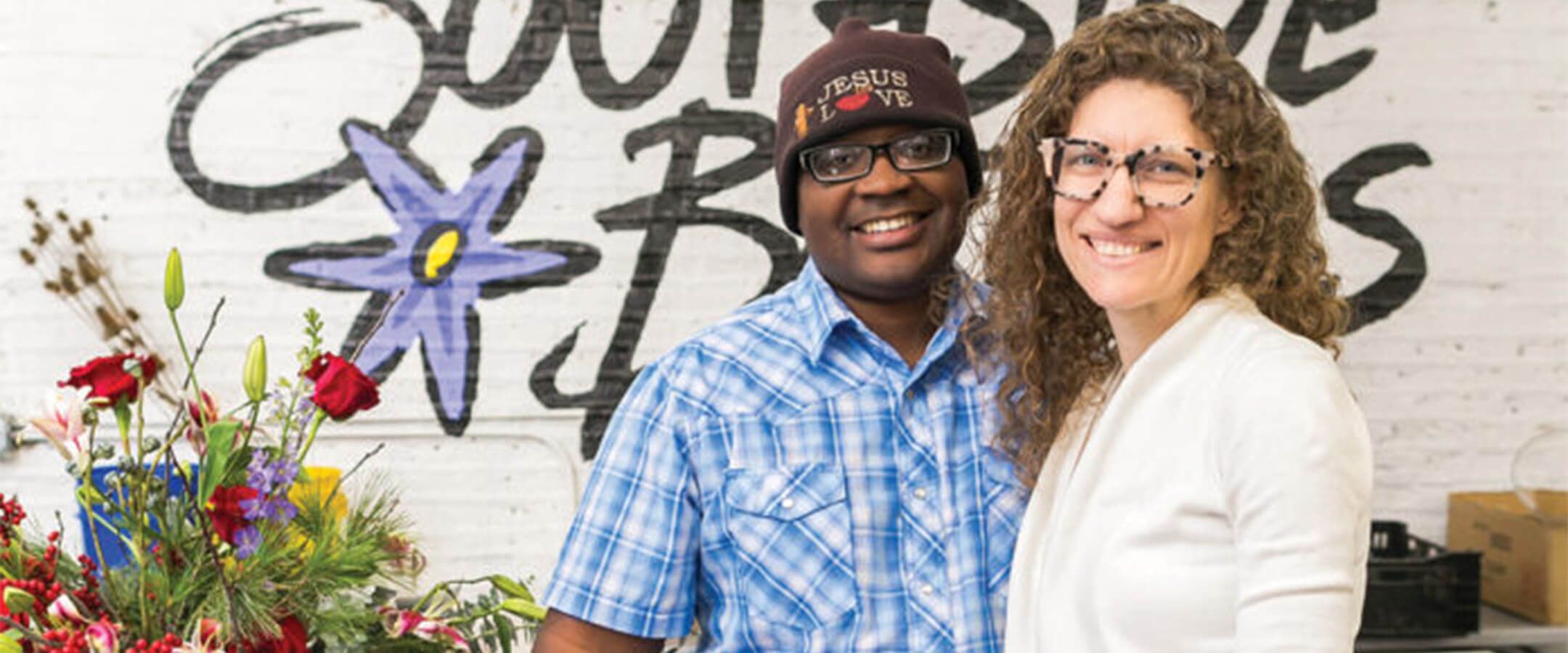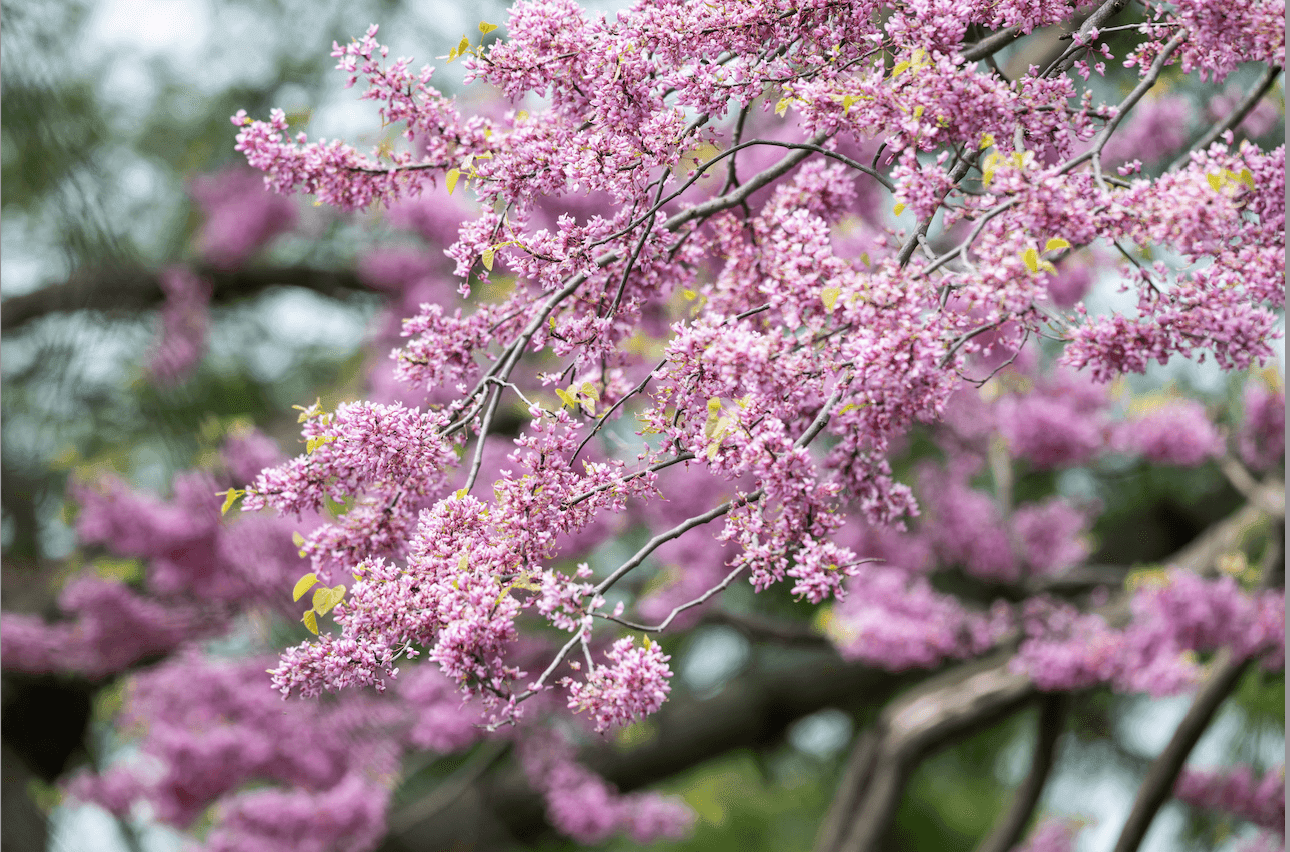The afternoon of Saturday, May 30, looked like any other in Madison as demonstrators gathered on the capitol square to peacefully protest police brutality and racism.
The evening: tear gas, broken windows, riot gear.
Clashes between protestors and police left many State Street storefronts shattered, defaced, and eventually boarded up to prevent further destruction. To some Madisonians, it was yet another summer staple — strolling along and window-shopping State Street — taken away.
To others, however, the protests were a new beginning, a moment of reckoning — a blank canvas, so to speak. Not long after the boards went up, so, too, did the ladders, the paintbrushes, and the voices of Madison as artists reflected the movement, the moment, and the community onto those empty boards.
Any Badger who knows the heart and history of activism that run so deep at UW–Madison can correctly assume that many of the brains and brushstrokes behind the work that adorns State Street have UW roots.
The Brains
The protests in Madison escalated on a Saturday night. By Sunday morning, the City of Madison had contacted Karin Wolf ’97 MS’06, Madison Arts program administrator, to take the lead on a State Street mural project. Over the next several days, Wolf took on what she calls the most challenging project of her career, not only in scale and timing, but also in the weight of its meaning during a social justice movement.
“I was very concerned about that assignment because I know that people are anxious for healing and anxious to return to normal, between COVID and the divisiveness of our national political scene, the racial pain that is just palpable right now,” Wolf says. “But I also know that you cannot heal when you are still on the surgery table, getting the cancer taken out, and that it would be hard to do a project like that and not have it appear to be about beautifying, or healing, or whitewashing very, very important issues.”
According to Wolf, she was given 48 hours to start the project, which included contacting artists, assigning and reserving spaces for painting, processing paperwork, and ensuring the success of what normally would take months in a matter of days.
“I did as much strategizing and planning and work as I possibly could in those two days to make sure that it was not a complete and utter disaster,” Wolf says.
Unlike most public art projects, which seek out artists based on timeliness and professionalism, the open call for State Street muralists sought those who were strong in will and in spirit. To fill the eight open boards that first day of painting, Wolf sifted through more than 100 local artists, ranging from seasoned professionals to students looking to put their hobby or passion into action.
“Part of my agenda was just amplifying voices of people who have been impacted by racialized violence and providing them what should be provided to all of us in a democracy, which is freedom of expression,” Wolf says. “And usually you can't do that. It’s a very dangerous thing to do because it’s very difficult to do, especially in government. I knew that this opportunity was a poisonous snake, and I knew that this opportunity was a golden ticket, and I had to hold both of those in my hand the entire time.”
In addition to overseeing the logistics of putting artists on State Street and murals on boards, Wolf also had to prepare artists for the emotional toll and potential backlash for participating in such a project — all while considering the possibility of further damage and risks to the artists’ safety in the midst of protests.
“Artists have been threatened for being part of this project for many, many different reasons: for being sellouts and working with the state who’s doing the oppression, for saying that Black Lives Matter. They’ve taken a lot of hate, and a lot of heat, so I need to make sure that they are 100 percent ready for that if they are taking that on,” Wolf says.
Though powerful reminders of a period of turmoil and reckoning, the boards on State Street gradually came down as businesses cautiously inched toward a semblance of normalcy. According to Wolf, the future of the boards is still uncertain as artists and local art spaces contend with possibilities for their preservation, but for her, the impact of these artworks lies in her original goal for their creation: freedom of expression. The murals were an outlet for the overwhelming emotions that accompanied, resulted from, and fueled the demonstrations.
“My desired result is to demonstrate democracy; to give artists canvas without fear of reprisal or censorship; to allow people to release some of the pressure and tension of the moment through artistic expression,” Wolf says. “That was also in my call to them: I’m asking artists to create a response to the moment, whatever that response is.”
Among Wolf’s gathering of artists, naturally, Badgers were in the mix.
The Brushstrokes
Painted Bodies


“People destroyed this space because of their anger about the destruction of Black and Brown bodies. Why not come and reclaim this space with my Black and Brownness and turn it into something, not necessarily beautiful … but into something that would be acknowledged?” Sirena Flores x’21 asked herself upon being given the opportunity to paint on State Street.
The daughter of an artist and granddaughter of Madison art leader Sharon Kilfoy ’72 MA’80, Flores herself is an artist, activist, and longtime member of the UW’s Precollege Enrichment Opportunity Program for Learning Excellence. She grew up immersed in a tradition of community art and mural-making. However, what started for her as a meditative practice and family affair has recently become a platform for her activism.
Karin Wolf first contacted Flores’s mother, whom Flores identifies as a Latina, to create a mural downtown. However, she handed the opportunity to Flores, who identifies racially and ethnically as Afro-Latina. A portrait artist by nature, Flores would paint the graduation photo of her late friend, Tony Robinson, who was killed by police in 2015.
“[Graduation] was just such a significant positive moment in his life,” Flores says. “When we talk about Black Lives Matter, [we talk about] my life having meaning: don’t end my life because my life has so much purpose. I think it’s important to recognize Tony’s humanity — to not recognize his death, but to recognize who he was while he was living.”
Flores also painted a second mural that features the rallying cry “Our existence is resistance” on a black background adorned with monarch butterflies, a visual that pays homage to the Black Lives Matter movement and the migratory roots of both Latinx and African American communities. According to Flores, it’s a statement that she not only believes, but that she also embodies.
“The fact [of my] being Afro-Latina [means] my existence is resistance,” Flores says. “The fact that you can’t sweep me away. The fact that I will continue to be more and more powerful throughout my education. You can’t kill me. You can’t silence me.”
Flores added that the essence of the project itself lies in the anger and frustration that will also persist long after the boards are removed without the change that they were meant to inspire.
“The art on State Street is beautiful. What we did was very powerful, but let's remember how we even got to that point,” Flores says.
“We have to remember that those boards went up because of something else that people were experiencing. We can’t just allow ourselves to mask that feeling of anger and that feeling of sadness. We need to acknowledge … the anger and frustration that went behind it and still [accept] that people are angry about lives being taken, lives being abused.”
No Whitewash

Daniella Echeverría ’20, a local artist, also incorporated a common phrase from the Black Lives Matter movement into her mural, which reads “Silence is violence.” While she welcomed the opportunity to contribute to the project, she also didn’t want her mural to contribute to the “whitewashing” of the events that led up to it.
“I think that sitting with the discomfort of boarded-up windows could have lasted longer because this kind of violence is the kind of violence that the Black community sees all the time and the Brown community sees all the time,” Echeverría says. “I didn’t want the mural to be something that perpetuated just pretending these protests and these riots aren’t happening.”
To ensure that her piece captured the essence of the moment rather than masked it, Echeverría turned to her degree in horticulture, drawing upon themes of the ecological importance of fire and burning to the renewal of plant life. Skulls flank her words as a stark reminder that many of these efforts are still made at the expense of people’s lives.
After passers-by thanked her for “putting a positive spin on things” with her mural, Echeverría began speaking out to clarify the motive and message behind her piece.
“I just wanted to make sure that [people] knew that that’s not at all what I was trying to do,” she says. “I didn’t end up putting up the words until the very end. The words were meant to be there from the beginning. … But I wished that I had painted it sooner so that people had a better idea of what I was thinking from the get-go.”
However, Echeverría warns that it’s going to take more than pausing on the sidewalk and musing abouta mural to see the change for which this artwork was only meant to be a starting point — and it may not be as pleasant as a gallery walk down State Street.
“If one person did something differently because there’s some artwork on State Street, I think that that’s wonderful, but it’s going to take a lot more than that,” she says. “It’s going to take everybody and it’s going to be hard and people are going to really be uncomfortable with themselves.”
Words and Pictures

As a First Wave scholar, Isha Camara x’21’s first artistic language is poetry. Camara was in her hometown of Minneapolis at the time of George Floyd’s death and the subsequent protests. Unable to participate because of precautions regarding the pandemic, sheturned to art as activism well before the first drop cloths were spread on State Street.
“There was this moment of helplessness when I found out I couldn’t go to a protest because I was thinking about the physicality of activism and not the other ways that activism works,” Camara says.
A self-taught portrait artist, Camara began taking donation-based commissions for artwork. She worked tirelessly for weeks, completing in one day what typically would have taken her months to finish. Three weeks and 63 portraits later, Camara raised nearly $2,000, which she donated to GoFundMes, people needing rent assistance, and local Minneapolis nonprofits such as On My Block and Juxtaposition.
However, while proud of her contribution, it was the intense labor of churning out portraits and the concern from family for her own well-being that inspired her State Street mural, which features an Audre Lorde quote that reads, “Caring for myself is not self-indulgence. It is self-preservation, and that is an act of political warfare.”
“There’s no way that activism or a revolution can happen if we’re all burned out,” Camara says. “It’s sometimes really frustrating to see my loved ones on the forefront of things for so long. And I’m wondering who’s checking in on them. Who’s letting them take a break, letting them be in the back seat? Because I think no one wants to see a bunch of people doing the work around them that they feel like they can do, too. But I do think that some people are very comfortable with allowing the same group of people to advocate for themselves.”
Her mural is also a reminder that she is not going anywhere.
“I [think refusing to burn out] is sustainability, is defiance, and is the ability to make the world aware that you’re still here, and you’re here for the long run until things are changed,” Camara says. “You are not easily moved. You are not easily forgettable.”
Camara’s mural features an image of a Black child — a nod to her belief in the future — and a tribute to the Gil Scott-Heron poem: “The Revolution Will Not Be Televised.”
“He’s going into the fact that people really changing their thoughts and ideology usually happens in private,” she says. “I think that real healing and real change for yourself and your people and your friends and community are those transformative moments that people don’t see besides yourself. You always bear witness to yourself.”
Regarding the artworks’ lasting impact, Camara worries that art, when considered political,becomes a “novelty” — that those who consume it for enjoyment gloss over the pain that merited its creation.
“I need people to be aware that there is nothing lighthearted about people dying. At all. There’s nothing lighthearted about tear gas. There’s nothing lighthearted about bail funds,” Camara says. “When art is made by the community, for the community, it’s geared towards the comfort and healing and joy and anger of the community focusing on whatever the community needs to collect themselves.”
But, true to her mural’s message, in order to care for her community through her art, Camara first had to care for herself.
“I wanted people to see [my mural] and feel at ease,” Camara says. “It was a lot of self-care for me to do it, to be up on that ladder painting, like I was in my own world. I didn’t feel like everything was on fire, and so I wanted that sense of peace to come to the people, too. I just hope that that sense of peace lingers longer in Madison.”
Space

When asked what she wanted to paint in the space she was given, Shiloah Coley ‘20’s answer was simple: “I really just want two Black teenagers to take up space.”
A Posse, Truman, and McNair Scholar and formercoeditor of the UW’s The Black Voice, Coley describes her art as an exploration, deconstruction, and reconstruction of Black identities and an examination of the difference between the perception and lived experience of Blackness. Her research focuses on the impact and accessibility of art in low-income Black and Brown communities.
In planning her mural, Coley researched casesof young Black children who had been killed by police. She came upon seven-year-old Aiyana Mo’Nay Stanley Jones and 14-year-old Cameron Tillman, who became the inspiration for the children in the piece and whose stories she posted near the mural.
“It’s not meant to be an exact representation of them. I don’t mean for people to see it and immediately tie it to those two cases of kids who were killed, but it's important for me to acknowledge it because the goal was to reimagine them a little bit if they had an opportunity to grow up,” Coley says.
According to Coley, the intentional ambiguity in the piece allows comfort and ease to some while still inciting self-reflection in others.
“Some people walk by it and are like, ‘Wow, this reminds me of a Black mother and a child.’ And that's a really beautiful thing for Black mothers to walk by and think,” Coley says. “If it brings comfort to people, that’s really beautiful, especially for Black folks. If it forces white folks to confront themselves and their own ideas about race, that’s great.”
In addition to an opportunity to create, Coley also found on State Street a Black artistic community that she had yet to see in Madison.
“[To] work in the community, and to be painting a mural and you see all these other Black artists out there and to find out they’re all artists — graffiti artists, teaching artists, art educators — in the community was just a really beautiful experience, to see us all be unified in one space,” Coley says. “I met more Black women artists over the course of [that] week than I might have met during my four years at UW.”
Beyond Madison’s artistic circles, Coley also noted the invaluable opportunity the project presented in bridging the divide between campus and the greater Madison community.
“There were so many Black folks, and Black families who would come up and just say it was so beautiful to walk up and down the street with their kids, and have their kids see Black artists making work centered around Black people,” Coley says.
To broaden the positive impact of her mural, Coley took her activism a step further by selling stickers that featured the mural’s image and donating the proceeds — nearly $1,500 — to the Alternatives, Inc. Family Relief Fund in Chicago and Save the Children’s Yemen Children’s Relief Fund.
As the boards inevitably come down, Coley hopes that the art will live on through the thought and reflection she tried to provoke in her viewers.
“My hope for folks who walked by, for the Madison community, is that it forces them to critically think,” Coley says. “With my work, I say I am responsible for the image. I’m not responsible for what people think about it. My job is to start a conversation, but I don’t control where it goes after that.”
She does, however, hope that conversation does not stop at appreciation for the art as a pretty picture to cover the problem at hand.
“I really, really challenged folks to think beyond that and really analyze what their gut feeling and response is to the work they’re seeing, because that says more about them and the work that they need to do, more so than it even says about the art or the artists, in my opinion.”
To Be Held

Keysha Mabra ’08, a local artist and art therapy advocate, saw the State Street mural project as an opportunity to assist others in their own journeys of self-growth.
“I think it’s fascinating to see people of all walks of life looking at the piece and … what the shapes and colors and words trigger within them,” Mabra says.
Though initially drawn to the project’s promise of artistic exposure, Mabra’s work quickly became less about her as the artist and more about what her work could do for its viewers.
“I wanted to really make a statement about the dedication that I was willing to give so that the people who are viewing this could see something that they could pull something out of,” Mabra says.
Currently in recovery from addiction, Mabra wanted her pieces — collages that feature images of houses and hearts — to serve as beacons of support for others who were struggling and did not have access to treatment centers or community because of the pandemic.
“I wanted for them to see that there is hope for them,” Mabra says. “I just wanted them to see visually, if not physically, being able to have someone holding them, or talking to them in person about how they can get through an experience.”
Mabra sees the art on State Street not as a mask for the grim reality that necessitated it, but as another outlet into which folks can channel their emotions.
“There's a healthy release of the anger. The art is of various forms of anger, of specific treatment of Black people over time … with the overall message — enough is enough — that you see on some of the walls,” Mabra says.
“When you look at the walls differently and you see that there’s this beautiful mural of someone’s expressiveness, [it’s] what’s coming out from within their own heart and soul so that other people might see this beauty.”
Mabra also believes in the dynamic ability of public art to meet people where they are in terms of their beliefs and challenge them to think critically in order to grow.
“[Public art] causes people to step back and make a choice about if they’re going to jump into another perception other than what’s going on in their mind when they look at it, or if they’re going to just walk by and continue being stuck in the day-to-day tasks and not really acknowledge what they see around them,” Mabra says.
“Or, if they're going to use it as an opportunity to learn something new about how another person is seeing things around them and then decide what to do with that for their own lives.”




